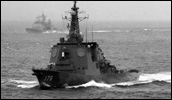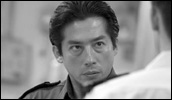Aegis
- Year
- 2005
- Original title
- Bokoku no Aegis
- Japanese title
- 亡国のイージス
- Director
- Cast
- Running time
- 119 minutes
- Published
- 28 May 2006



by Adam Campbell
Having yet to see Yamato or Lorelei, Aegis is my first dip into the sea-faring releases of 2005. As with Lorelei, Aegis is a fictional story which sprung from the mind of author Harutoshi Fukui. Rather than the science fiction spin of Lorelei, however, Aegis is much more in the mould of Hollywood action films. Indeed, the plot of the film is barely a lawsuit away from that of the Steven Segal shoot 'em up Under Siege. Hiroyuki Sanada plays Sengoku, Chief Petty Officer onboard the Japanese Maritime Self Defence Force ship Isokaze. During a training exercise, the ship is taken over by foreign agents and mutinous officers. While the rest of the crew are forced to abandon the ship, the terrorists make their intentions known to the government. Unless their demands are met, the Isokaze will fire an American chemical weapon into Tokyo. Ever the dedicated seaman, Sengoku finds a way back onto the ship to wrest the Isokaze away from the terrorists.
Sanada turns in a fine performance as the folksy Sengoku, a doting father to both his family and crew. However, his transformation from mild-mannered officer to unstoppable duty-obsessed super sailor is not entirely plausible. Any fault here lies mostly with the script rather than Sanada, who sets excellent ground work and has spent half his career kicking people's asses convincingly. Masanobu Ando is unforgivably wasted in this film in a thanklessly small and forgettable role as a background terrorist. Baby-faced Ryo Katsuji plays Sanada's sidekick on the boat and does so unremarkably that I couldn't help but wonder what Ando might have been able to bring to that role had he been given the part.
Director Junji Sakamoto navigates the interior of his ship competently, corridors bathed in the red warning lights we've come to expect from naval pictures. He returns several times to the same locations onboard the Isokaze which helps to separate out the faceless areas into theatre-like stages, though little effort is made to give us our overall bearings onboard. Sakamoto handles the thriller aspects well, especially noticeable toward the start where loyalties shift repeatedly over half an hour. Ambiguous flashback sequences occasionally add motivation, are misinterpreted and reinterpreted. The first forty-five minutes which set the scene and the stakes are capably handled, but the film fails to move into gear, even when the stirring music blasts to let you know you are meant to be excited.
While Sakamoto had a good grip on developing the situation, he misses the action beats to drive the film on. After the takeover of the Isokaze, the director further splits our focus between Sanada's efforts to retake the ship, a growing rift between the two terrorist groups on the bridge and the deliberations of the Japanese government as they debate the proper course of action. While this approach to concurrent drama can work very well to make the most mediocre of events thrilling, on the television show 24 for instance, here it serves the exact opposite effect, causing the film to drag and lose momentum. For instance, upon infiltrating the ship, Sanada spends twenty minutes of running time trapped in an empty room while the bureaucrat story gets aired out. When characters are off screen they appear to be doing nothing at all and this is especially true of Sanada's character, who is meant to be risking it all in his do-or-die mission.
Much has been made of the political content of the film and quite who the enemy is forms somewhat of a sticky question in Aegis. The finger seems to be pointed at two targets, the threat from outside (Korea, China, or in the case of this film, some unidentified hazy crazy mix) and the threat from within, identified here as a weak bureaucracy under the thumb of the Americans. Somebody along the line obviously realised that this kind of material is more effective when wrapped up in an action drama than when blasted from the loudspeakers of a black van. The terrorists are threatening Japan with a U.S.-developed chemical weapon, made in Japan by the States. The motivation for the crew rebellion and outrage is the American bombing of their own weapon facility in Okinawa. Our plucky band of nationalists stole this chemical weapon while the U.S. Army were transporting it around Japan. And the special type of bomb which can destroy this chemical weapon comes from where? Yes, you guessed it, the United States. Can you see where this is going? "So we do the dirty work," the Prime Minister moans at one point. Even the conversations of the SDF wingmen en route to intercept the ship are in English with katakana subtitles. Is the potential bombing of the heroic Sanada going to be blamed on foreigners too?
The mutinous crew members are inspired by a right wing thesis which questions Japan's place in the modern world. "Today this country has been separated from its national essence," says the thesis, as the flag of Japanese Maritime Self Defence Force waves proudly in the wind. The same flag that resonates across Asia as the insignia of the Imperial Japanese Navy, since it was never changed. The hero of the bureaucracy scenes, a dashing intelligence agent sitting at the powwow with the PM, expresses similar ideas of a 'drifting Japan' (implicit in the title) which, he complains, now "waits to see which way the wind is blowing" before deciding anything. Presumably he preferred it when they took the initiative in the 1930s.
The foreign terrorists seem sympathetic to this idea that Japan should regain former 'status', and this does not strike any of the crew as suspicious until long after the plot is afoot. Naturally, this Pan-Asian alliance turns out to be merely a ruse for some good old fashioned Japan hating. The Korean/Chinese forces have no agenda more complicated than to destroy Japan for whatever reason they want to do these things. Further details can no doubt be found in the tabloid newspapers. Once the alliance breaks down, the implication is that the Japanese crew aren't so bad, because they were going to destroy Tokyo for all the 'right' reasons!
Not that having a right wing undercurrent necessarily disqualifies Aegis from being worth a watch. The film raises some points for discussion; it's refreshing to see a blockbuster film that actually has something to say, and stirs up some controversy for better or worse. While no great achievement and considerably uneven, Aegis can be quite diverting entertainment when it's working well. Fans of the Yuji Oda film Whiteout, which also owed a lot to Hollywood films like Die Hard, could find Aegis appeals to them as well. Yet once again it is another Japanese film in recent years to fall prey to being badly paced. Watching languid pieces like this and Casshern, which take apparently exciting premises and string them out to a mind-bending infinity, certainly makes you appreciate more how Aoyama and Kurosawa were able to make engaging cinema out of three hours, or Suzuki out of ninety minutes.